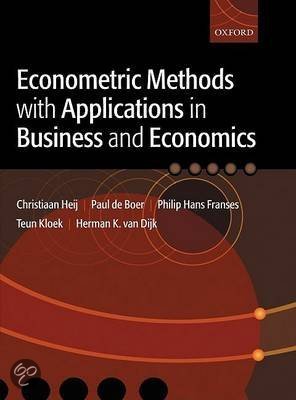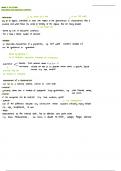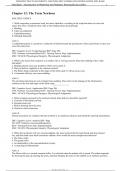7 1
.
Linear Regression model
we want to find a line that best fits the given data ,
consider the
linear model in parameters :
li =
2
+ BKki + Ei ,
=
1 ...
where : Yi : dependent variable
Chi :
explanatory variable
n :
sample size
Ei :
error term that captures the variation in yi not explained by
usually, Coefficient Bi can be interpreted as partial marginal effect
Bi =
0ESYilChi . . . . . Thkin] K = 1
,
. .
.,
K
8 k,
1 2
. .
Least Squares
the most simple linear model I
has explanatory variable :
Hi = x +
BXli + Ei i = 1,
...,
N
where we want to find < B use OLS -
· minimise the sum of squared residuals
the residual :ei Yi-x-Bli =
12 . B) =
argmin & 2Sn(x . B) =
argmin E (Yi-x .
Bi e
now ,
take partial derivatives to
get B :
8 (Sn(d B) ,
= -
2 [F .
(Yi X-Bl(i)
- =
O
8
.. 2
1((yi B[((i) y B
=
=
- -
0 (Sn(X B) 2 [i (Yi x-Bli) Ki O
-
=
= -
,
OB
*
plug in value for : [ .. <(i)(yi-y) -B((i ii) - =
0
:
B =
[i < i(yi -Y) =
[iKli -
< i) (yi i) -
[i xi(ki TL) [i ((i 5)
:
- -
variables transformed *= Y C
·
When are s t .
.:
Yi dy +
by Yi & = + balLi
B
=by
↑
&** =
*
then axB byi
dy-by
+
adding constants to yidcli doesn't influence but multiplying all Yid K:
scales B (up/down) ,
while I absorbs all location changes in <id yi
, .
1 3 .
Binary regressor
When xi =
Di is a
dummy binary e .
g. male or female ,
then :
assuming n =
no +
n, where n =
[Di (#obs where Di . = 1)
* [: Mei M135 - MoJo Yo
-
=
Di(yi-y) = -
My = (n -
=
J .
-
[i Di (Di-D) n
-
,
n B n
-
M
I
j B5 y Yo) 5 Mej Mojo 14 40 To
15
(M)
+
-
-
-
= =
-
= - =
,
1 .
4 Goodness of fit R2
> fitted value
generic decomposition of data :
Yi =
Yi + : > residuals
SST =
SSE + SSR
* fitted value i : = < +
B : (the projected value of Yi on the line < + B <li
* residual ii : =
yi-x-Bxi (what remains once we've done the projection)
Liyie 0 =
they are orthogonal to each other (irrespective of the regressor)
* the OLS estimator minimises the SSR4 maximises the SSE
the ratio of explaineda unexplained variance of yi is :
SST = SSE + SSR
SST SST 58 T
explained variance :
SSE =
R2 maximised want to :·
explain yi as best
SST as we can with
2i
unexplained variance : SSR = 1-R2
SST
· When multiple models choose one with highest R2
comparing ,
=>
high R2 doesn't guarantee better predictions doesn't say anything about out-of- :
sample predictions to choose a
good model ,
must consider :
4) in- sample
(2) Out-of-sample
1 5 .
Linear model motivation (3) non-statistical considerations
1. Reduced form models are driven by heuristic observations about potential relationships
between certain variables. These models are hard to make predictions outside of the obs.
at hand. They focus on internal validity.
2. Structural form models are generally derived from certain types of economic models (e.g.
profit maximisation). They are restrictive but can tell us a lot about out of sample
prediction. They focus on external validity.
3. Microeconomics focusses on individual consumers, firms & micro-level decision makers etc.
It uses disaggregated cross-section & panel data.
4. Macroeconomics focusses on price levels, money supply, exchange rates, output,
investment, economic growth etc. It uses aggregated time-series data.
5. Interpolation is computing the predicted value of yi for non-existing xi values in-between
existing values in the data.
6. Extrapolation is computed the predicted value of yi for non-existing xi values that are
outside its range.
, Inclusion
1 6 .
of a constant
if we drop the constant there are some drawbacks : ,
·
Ols can't be related to correlation coefficient between Kid Y :
·
OLS isn't invariant to transformations
·
if true model contains non-zero constant , B is biased a inconsistent
·
R2 interpretation as squared correlation
coefficient no longer holds
·
loss of reference group if regressor is a binary variable
only benefit
:
estimator has lower variance ...
more efficient if true x =
o
1 . 7* Classical assumptions of linear regressions :
(i)
Exogeneity : < [ikli-ill
.....
O Cn is fixed they satisfy
,
:
(ii) Random disturbances E . . . . . . En are random variables with ECEilTli] : 8 =
(iii) Homoskedasticity variance of 2 , En exists & are all equal
:
Ele11i] 08 .... ,
=
O
(iv) Independence E ...... En are independent after conditioning on <4 ....,
:
n
Fixed parameters % fixed
(v)
true parameters do Bo &0 are unknown parameless
:
,
Linear model data on y ...... In is generated by :
Yi Lo + Boli Ei : = +
(vii) Normality : E
, ....
En are jointly normally distributed
* from (ii) E(Eil(i] E(EiCli] 0 & (ii) E(Ei]
0 =>
by LIE 0
= =
on
: : =
* (vii) hardly used : not satisfied for economic data ,
additionally (viil is
redundant for large samples
1 8 .
Bids & variance of as estimator
# theorem 1 8 1 .
.
let random variables be drawn from some distribution with parameters to d Bo ,
so :
(Hi ,
Yi) ~ P(C6 4/Xo Bo
, , .
. . .
) I = 1
,
. .
.,
M
then ,
24 are unbiased estimators of N
20 Bo if :
E() : Lo ECB) d :
Bo
that both expectations exist
assuming
Ols estimators are unbiased :
: )
Eikli-fi
N
B =
[i(i 9) (Yi -5) -
Bo + E:
[i (li-ii)2 [i (i -5) 2
(ii)
Ei(i-ei)
ECBK4 ..... n]
E(Bo I
E:
& Bo O
+
:
=
ki .... n
= +
[i (i -5) 2
ECBIT4 , ..., <(n) =
E(Bol , , .... (n) =
Bo ,
by LIE :
E(B] =
E(BITh ,..., (n) =
Bo
is an unbiased estimator for Bo
- ·
j B Bo BT
-
L xo
=
=
+ +
-
-
=
ECQ19h ,..., (n) = <0 E(j(Bo-B)(yh
+
, ..., 7(n) +
ECEITh ,
..
.. (n) = 20 + 0 + O
* is an unbiased estimator for Xo







